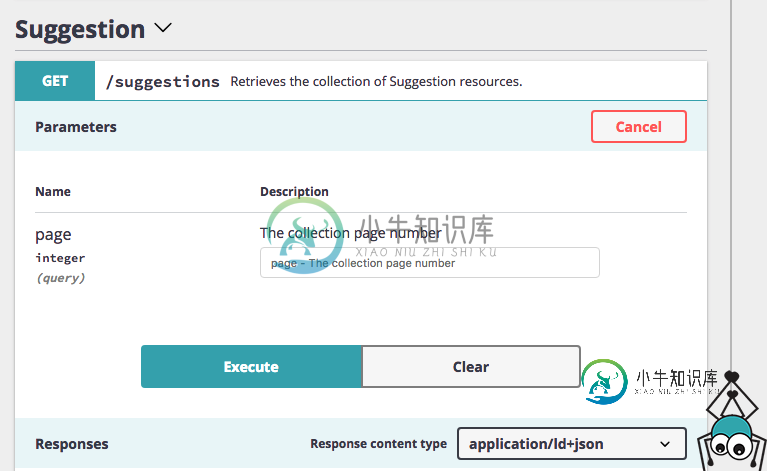如何使用大摇大摆的文档在 API 平台的endpoint中请求额外的 GET 参数?
我有一个symfony项目,在那里我使用api平台。
我有一个实体,并且有它的数据提供程序。我在为收集终结点定义其他参数时遇到问题。
一个实体叫做建议。它必须从弹性搜索返回文档集合。
endpoint是:
/suggestion
此endpoint侦听其他GET参数:
页面,级别
每次请求endpoint时都会读取这两个参数。
在我的< code > suggestions collection data provider . PHP 类中,我有:
/**
* Retrieves a collection.
*
* @param string $resourceClass
* @param string|null $operationName
* @return \Generator
*/
public function getCollection(string $resourceClass, string $operationName = null): \Generator
{
$query = $this->requestStack->getCurrentRequest()->query;
// I am reading these two parameters from RequestStack
// this one is built-in
$page = max($query->get('page', 1), 1);
// this is a custom one
$level = $query->get('level', 0);
...
在我的SuggestionRepository中。php类:
/**
* @return \Generator
*/
public function find(int $page, int $level): \Generator
{
// here I can process with $level without problems
Page参数是默认参数,它是在集合的swagger中生成的。
API平台生成的Swagger文档截图:

但是页面参数现在是唯一的参数,可以在网页版中编辑。
我需要添加更多参数(在本例中为级别)来招摇和描述它们,以便用户/测试人员知道哪个参数实际进入此endpoint。
如何告诉api-platform,我希望api的用户/测试人员(从客户端)输入一些其他参数,例如< code>level?
共有3个答案
如果有人需要执行类似操作,但使用 XML 配置:
<collectionOperation name="find_duplicated_items">
<attribute name="method">GET</attribute>
<attribute name="path">/items/find_duplicates</attribute>
<attribute name="controller">App\Infrastructure\Http\Items\FindDuplicates</attribute>
<attribute name="openapi_context">
<attribute name="parameters">
<attribute>
<attribute name="name">someProperty</attribute>
<attribute name="in">query</attribute>
<attribute name="required">true</attribute>
<attribute name="description">List foos and bars</attribute>
<attribute name="schema">
<attribute name="type">array</attribute>
<attribute name="items">
<attribute name="type">integer</attribute>
</attribute>
</attribute>
</attribute>
<attribute>
<attribute name="name">ageDays</attribute>
<attribute name="in">query</attribute>
<attribute name="required">false</attribute>
<attribute name="description">Max age in days</attribute>
<attribute name="default">5</attribute>
<attribute name="schema">
<attribute name="type">integer</attribute>
</attribute>
</attribute>
</attribute>
</attribute>
</collectionOperation>
这给了你这个:
在Api Platform核心版本2.4.6中,在get注释中添加“swagger_context”对我来说不起作用
就我而言,我不得不稍微偏离说明。在重写的规范化方法中,我必须先删除现有参数,然后将自定义定义添加到$doc参数数组中。正如pedrouan所做的那样,我能够添加require=true属性,并且它以相同的方式工作。
在services.yaml我补充说:
App\Swagger\SwaggerEventRequireDecorator:
decorates: 'api_platform.swagger.normalizer.api_gateway'
arguments: [ '@App\Swagger\SwaggerEventRequireDecorator.inner' ]
autoconfigure: false
在App\Swagger文件夹中,我添加了以下类:
<?php
namespace App\Swagger;
use Symfony\Component\Serializer\Normalizer\NormalizerInterface;
final class SwaggerEventRequireDecorator implements NormalizerInterface
{
private $decorated;
public function __construct(NormalizerInterface $decorated)
{
$this->decorated = $decorated;
}
public function normalize($object, $format = null, array $context = [])
{
$docs = $this->decorated->normalize($object, $format, $context);
$customDefinition = [
'name' => 'event',
'description' => 'ID of the event the activities belong to.',
'in' => 'query',
'required' => 'true',
'type' => 'integer'
];
// e.g. remove an existing event parameter
$docs['paths']['/scheduleamap-api/activities']['get']['parameters'] = array_values(array_filter($docs['paths']['/scheduleamap-api/activities']['get']['parameters'], function ($param) {
return $param['name'] !== 'event';
}));
// e.g. add the new definition for event
$docs['paths']['/scheduleamap-api/activities']['get']['parameters'][] = $customDefinition;
// Remove other restricted parameters that will generate errors.
$docs['paths']['/scheduleamap-api/activities']['get']['parameters'] = array_values(array_filter($docs['paths']['/scheduleamap-api/activities']['get']['parameters'], function ($param) {
return $param['name'] !== 'event[]';
}));
return $docs;
}
public function supportsNormalization($data, $format = null)
{
return $this->decorated->supportsNormalization($data, $format);
}
}
注:
>
我还在services.yaml中将autowire和autoconfig设置为true。
我添加了一个自定义数据提供程序,要求在对活动实体资源的所有api请求中设置事件属性过滤器。上述自定义不需要在进行直接获取或url get请求时设置它。
终于想通了。
我还没有找到它的文档,但是我找到了一个方法。
在实体类<code>建议中。php</code>我添加了一些注释行:
namespace App\Entity;
use ApiPlatform\Core\Annotation\ApiProperty;
use ApiPlatform\Core\Annotation\ApiResource;
use Symfony\Component\Serializer\Annotation\Groups;
use Symfony\Component\Validator\Constraints as Assert;
/**
* Class Suggestion. Represents an entity for an item from the suggestion result set.
* @package App\Entity
* @ApiResource(
* collectionOperations={
* "get"={
* "method"="GET",
* "swagger_context" = {
* "parameters" = {
* {
* "name" = "level",
* "in" = "query",
* "description" = "Levels available in result",
* "required" = "true",
* "type" : "array",
* "items" : {
* "type" : "integer"
* }
* }
* }
* }
* }
* },
* itemOperations={"get"}
* )
*/
API平台swagger DOCs中的结果视图:
-
我有一个Spring应用程序,其中公开了两个rest接口供使用。一个是内部开发人员,另一个是客户。 Swagger确实生成了一个很好的文档,可以在/Swagger ui下访问。html 在此URL下显示内部和外部用户的文档。 以下是我的代码设置: 现在,我想把这些昂首阔步的文档分开。这样我们的内部开发人员就可以像 /留档/私有/swagger-ui.html和 /留档/公共/api-v1.html
-
有没有人用spring-data-rest配置了swagger。我知道swagger有DocumentationConfig类,它扫描所有spring-mvc请求映射。但是,如何将其用于spring-data-rest,因为没有定义显式的请求映射。非常感谢在这方面的任何帮助。此外,我还想知道,是否有其他支持Spring-Data-REST的文档框架。
-
我有一个API网关endpoint(/item/{itemId}),其中有一个路径参数'itemId'。下面是我用来在API网关中创建endpoint的招摇过市定义。 部署API后,当我将其导出为swagger定义时,导出的定义缺少“参数”对象,使其成为一个不完整的swagger文件。我也看到过同样的问题 已尝试从UI导出,如中所示https://docs.aws.amazon.com/apiga
-
嗯,标题很容易理解,但要详细说明: 编辑:根据@Anatoly的要求,这是昂首阔步的路线定义:
-
我创建了一个新的Web Api项目,添加了ASP.NET标识并配置了OAuth,如下所示: 谢了。 另外,我应该说Swagger文档对我所有的控制器都适用,只是我忽略了一个明显的方法--如何登录。
-
我们在我们的泽西应用程序中使用了@Role允许注释来限制用户对应用编程接口某些部分的访问。我们如何在SwaggerUI中显示这些信息? 到目前为止,我已经用@ApiOperation注释了方法以显示in/out参数,并尝试使用@Authorization/@AuthorizationScope,但我只为我们不使用的oauth2显示了它。最接近out case的是ApiKeyAuthDefiniti

